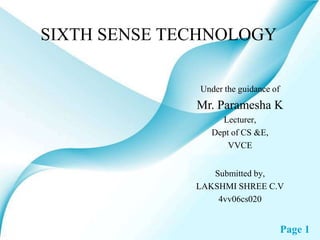28704893 sixth-sense-final-ppt
- 1. SIXTH SENSE TECHNOLOGY Under the guidance of Mr. Paramesha K Lecturer, Dept of CS &E, VVCE Submitted by, LAKSHMI SHREE C.V 4vv06cs020 Page 1
- 3. INTRODUCTION  Sixth Sense is a wearable gestural interface that augments the physical world around us with digital information and lets us use natural hand gestures to interact with that information.  It was developed by Pranav Mistry, a PhD student in the Fluid Interfaces Group at the MIT Media Lab.  SixthSense bridges the gap by bringing intangible, digital information out into the tangible world, and allowing us to interact with this information via natural hand  SixthSense comprises a pocket projector, a mirror and a camera. The hardware components are coupled in a pendant like mobile wearable device
- 5. COMPONENTS The hardware components are coupled in a pendant like mobile wearable device. Camera Projector Mirror Mobile Component Colored Markers
- 6. Camera  Captures an object in view and tracks the user’s hand gestures  It sends the data to smart phone  It acts as a digital eye, connecting you to the world of digital information
- 7. Projector  The projector projects visual information enabling surfaces and physical objects to be used as interfaces  The project itself contains a battery inside, with 3 hours of battery life.  A tiny LED projector displays data sent from the smart phone on any surface in view–object, wall, or person.
- 8. Mirror MIRROR  The usage of the mirror is significant as the projector dangles pointing downwards from the neck. Smart Phone  A Web-enabled smart phone in the user’s pocket processes the video data  Other software searches the Web and interprets the hand gestures
- 9. Color Markers  It is at the tip of the user’s fingers .  Marking the user’s fingers with red, yellow, green, and blue tape helps the webcam recognize gestures  The movements and arrangements of these makers are interpreted into gestures that act as interaction instructions for the projected application interfaces.
- 10. HOW IT WORKS? Send for processing capture Images Pictures Gestures Send Info Reflect on Project image desired surface Info on surface
- 11. Cont…  The hardware that makes Sixth Sense work is a pendant like mobile wearable interface  It has a camera, a mirror and a projector and is connected wirelessly to a bluetooth smart phone that can slip comfortably into one’s pocket  The camera recognizes individuals, images, pictures, gestures one makes with their hands  Information is sent to the Smartphone for processing  The downward-facing projector projects the output image on to the mirror  Mirror reflects image on to the desired surface  Thus, digital information is freed from its confines and placed in the physical world
- 12. RELATED TECHNOLOGIES  Augmented reality is a term for a live direct or indirect view of a physical real world environment whose elements are augmented by virtual computer generated imagery.  Gesture recognition is a topic in computer science and language technology with the goal of interpreting human gestures via mathematical algorithms.  Computer vision is the science and technology of machines that see. It is concerned with the theory behind artificial systems that extract information from images.  Radio Frequency Identification is basically an electronic tagging technology that allows the detection, tracking of tags and consequently the objects that they are affixed to.
- 13. APPLICATIONS
- 14. Make a call You can use the Sixth Sense to project a keypad onto your hand, then use that virtual keypad to make a call. Call up a map With the map application we can call up the map of our choice and then use thumbs and index fingers to navigate the map
- 15. Check the time Draw a circle on your wrist to get a virtual watch that gives you the correct time Create multimedia reading experiences Sixth Sense can be programmed to project related videos onto newspaper articles you are reading
- 16. Drawing application The drawing application lets the user draw on any surface by tracking the fingertip movements of the user’s index finger Zooming features The user can zoom in or zoom out using intuitive hand movements
- 17. Get product information Sixth Sense uses image recognition or marker technology to recognize products we pick up, then feeds us information on those products Get book information The system can project Amazon ratings on that book, as well as reviews and other relevant information
- 18. Get flight updates The system will recognize your boarding pass and let you know whether your flight is on time and if the gate has changed. Feed information on people The system will project relevant information about a person such as what they do, where they work, and so on.
- 19. Take pictures If you fashion your index fingers and thumbs into a square ("framing" gesture), the system will snap a photo. After taking the desired number of photos, we can project them onto a surface, and use gestures to sort through the photos, and organize and resize them.
- 20. ADVANTAGES Portable Supports multi-touch and multi-user interaction Connectedness between world and information Cost effective Data access directly from machine in real time Mind map the idea anywhere It is an open source
- 21. CONCLUSION Sixth Sense recognizes the objects around us, displaying information automatically and letting us to access it in any way we need The Sixth Sense prototype implements several applications that demonstrate the usefulness, viability and flexibility of the system Allowing us to interact with this information via natural hand gestures The potential of becoming the ultimate "transparent" user interface for accessing information about everything around us
- 23. THANK YOU






















